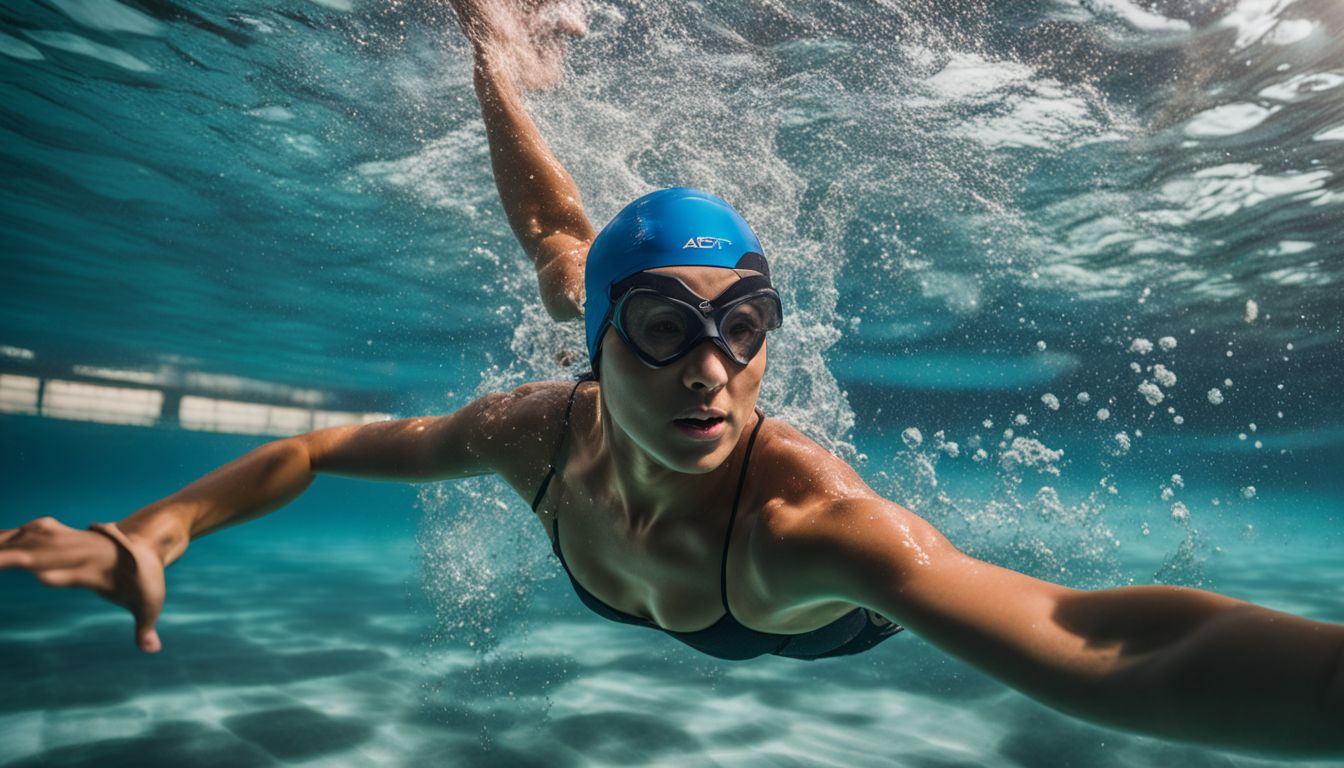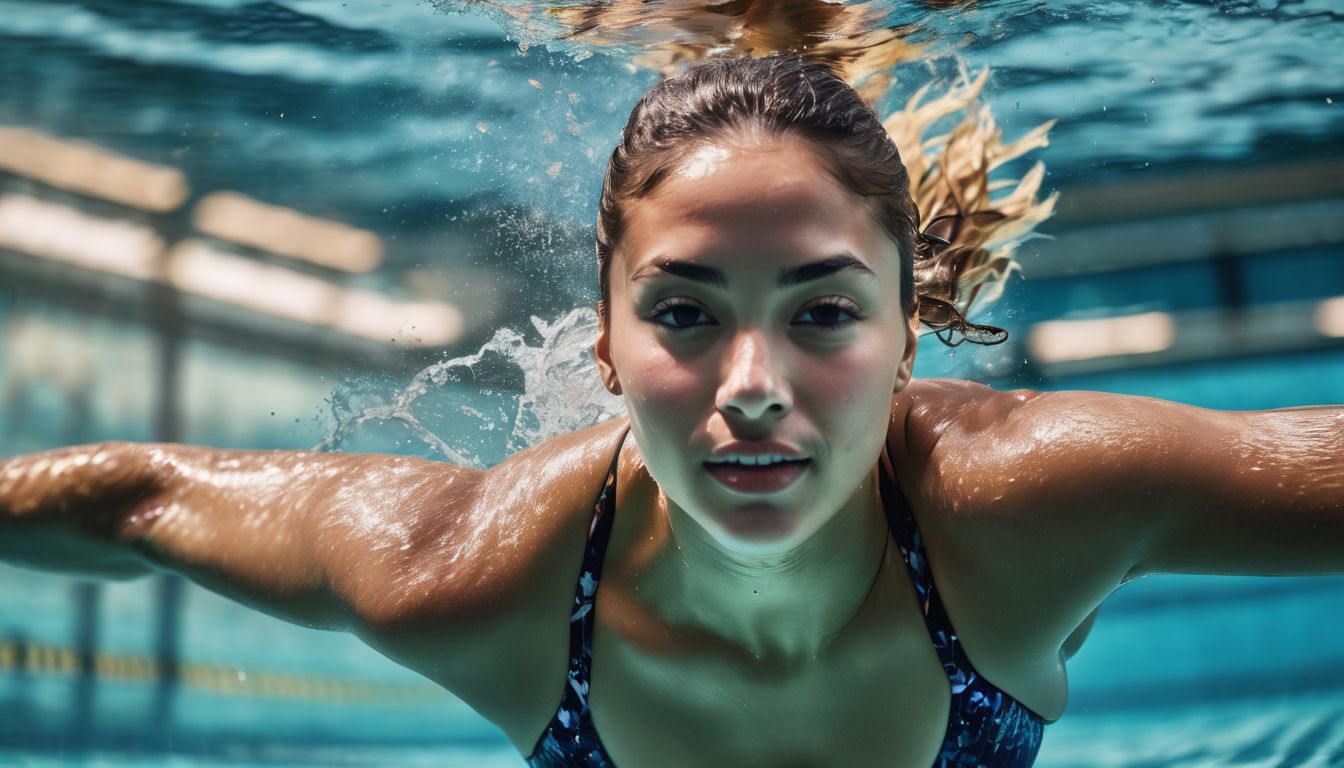The different types of swimming strokes
Learning different types of swimming strokes opens a new world of swimming to you. Each stroke uses different muscle groups in your body. This means you get a full-body workout when you swim.
You build strength all over your body, not just in one place.
There are more reasons too. If you want to be safe in the water, knowing different strokes can help. It’s also great if you dream of doing races or being part of competitive swimming events one day! A good swimmer knows how to do the four main techniques – front crawl, backstroke, breaststroke and butterfly.
These have their own special benefits and challenges for every swimmer to master.
How Does Freestyle Differ from Other Strokes?

Freestyle is special from other swim strokes. Both arms move in sync for this stroke. This is a different way to do it than other strokes. A constant flutter kick also helps in the freestyle stroke.
You face down into the water while doing freestyle swimming. Your body forms a straight line in this style. You turn your head to the side when you want to take air in. This breathing way varies from many others.
Freestyle is very fast and gets swimmers through water best of all methods used for races. It stands out there too.
What Makes the Butterfly Stroke Unique?
The butterfly stroke stands apart in the world of swimming. You swim it on your chest with both arms moving together. This is not seen in other strokes! The leg kick that goes with it is called “butterfly kick”.
Your legs must move like a dolphin’s tail, in a wave-like motion.
This stroke challenges most swimmers more than others do. It can make you tired fast but also gives you an excellent workout. Some fast swimmers breathe to one side or straight ahead during this stroke.
Remember, mastering the butterfly lets you show off unique skills and builds power in your body too!
How to Master the Breaststroke?
- Start by floating on your tummy in the water.
- Keep your body flat and level with the water’s surface.
- Your head should face down, towards the bottom of the pool.
- Keep your legs together and use a frog kick for movement.
- Pull your arms down in a semicircular motion.
- Make sure to keep your head and shoulders in line with your lower body.
- Aim to get most of the power from your leg kick, not arm movements.
- Practice this swim stroke until it feels easy and smooth.
- Take a breath by lifting your head when you pull your arm towards you.
- Turn your head to the side to breathe if needed.
- Try not to lift too much of your body out of the water while breathing or kicking.
- Work on speed and efficiency once you feel comfortable with this swimming style.
Learning how to swim the breaststroke takes time, but these steps can help you master it! These will also build strength in different muscle groups needed for swimming events! Want more tips? Come join us at Swim101 for expert-led swimming lessons!
What Are the Key Techniques for Backstroke?
Here are some tips to swim the backstroke well:
- Swim on your back.
- Your arm movements should be opposite and take turns.
- Use a flutter kick.
- Your body should be flat like a plank. This tip comes from Rebecca Adlington, a top British swimmer.
- Kick with a flutter kick – fast and small kicks with your legs.
- Make your arm movements long and fluid, which makes you move in the water easily.
- If your kick is not strong, you can use your shoulders to drive rotation.
- Keep your body horizontal in the water – this makes you sleek and fast!
- Look up with your eyes – this keeps your head in line with your body.
- Backstroke is great to mix with other strokes when you want to rest a bit but still keep swimming.
Is Sidestroke Still Relevant?
Yes, sidestroke is still important today. It is a mix of breaststroke, freestyle and sidestroke. Lifeguards use this type of swimming a lot in rescues. Sidestroke uses less energy than other types of swimming strokes.
This makes it very useful for long swims.
People can also use sidestroke as a way to stay safe in water. In fact, it’s often used for survival because it helps swimmers keep their head above the water’s surface easily. This lets them see where they’re going and take breaths when needed without much trouble! So, if you’re learning to swim or want to add more skills, don’t forget about the sidestroke!
How Do Strokes Vary in Competitive Swimming?
All swim strokes are not the same in races. Each one uses different muscles and skills. The freestyle swim is fast and used a lot in races. Swimmers move their arms and legs quick in the water to win.
The backstroke lets swimmers race while on their backs. Their arms move one after the other, with kicks from their legs. In breaststroke, swimmers pull their arms together and use a special leg kick to glide through water.
Another type is butterfly stroke. It needs strong moves where both arms swing up out of the water at once with a dolphin-like body wave. Sidestroke isn’t common for racing but still has use in life saving or relaxed swimming.
What Basic Skills of Swimming Should Every Swimmer Know?
Every swimmer should know the following basic skills:
- Floating: Learn how to float on your back and stomach to rest and regain energy in the water.
- Kicking: Practice kicking your legs to help propel yourself forward in the water.
- Arm movements: Learn proper arm movements for each swimming stroke to maximize efficiency.
- Breathing: Master the technique of taking breaths while swimming without interrupting your stroke.
- Body position: Maintain a streamlined body position in the water to reduce drag and increase speed.
- Submerging and resurfacing: Learn how to smoothly transition from being underwater to resurfacing for air.
- Treading water: Develop the ability to keep yourself afloat without using much energy by treading water.
- Water safety skills: Understand basic water safety rules, such as how to recognize and respond to emergencies.
Why Choose Swim101 for Your Swimming Lessons?
Swim101 is the perfect choice for your swimming lessons because they focus on teaching you different types of swimming strokes. Their experienced team of instructors will guide and encourage you throughout your journey to master these strokes.
Whether you’re a beginner or an advanced swimmer, Swim101 has lessons tailored to your needs. They prioritize independence by teaching survival strokes and ensuring that you can swim confidently for 15 meters using any stroke.
Swim101 also emphasizes practicing in various conditions to help you become comfortable with floating. So if you want to learn how to swim or improve your existing skills, choose Swim101 for their supportive and comprehensive approach to teaching different swimming strokes.
Frequently Ask Questions
What are the different swimming strokes taught by Swim101 swim school?
At Swim101, we aim to master the different types of swimming styles. Our program includes teaching the front crawl or freestyle, breaststroke, backstroke, and butterfly swimming. Each swimming style requires distinct arm strokes and kicks.
Can you explain the front crawl or freestyle stroke?
The front crawl, also known as freestyle, is the most efficient and fastest swimming stroke used. It consists of alternating arm movements over the surface of the water in front of the body, complemented by a flutter kick below the water.
What differentiates the butterfly style from other different swimming styles?
The butterfly style, known for its dolphin swim, is unique because it requires simultaneous arm movements. The arms move together from the water in front of the swimmer to behind their back, and the legs perform a synchronized dolphin kick.
What is the proper swimming technique for the dolphin swim?
The dolphin swim, a component of butterfly swimming, involves both legs moving up and down together. The key is to generate power from the hips while keeping the knees and ankles relaxed during the kick.
How is the swimming style of breaststroke executed?
Breaststroke involves simultaneous arm and leg movements. The hands perform an arc movement under the surface of the water while the legs do a specific "breaststroke kick." Despite being the slowest, the breaststroke is the first stroke usually learned and essential for various swimming tasks.
Why is freestyle stroke popular in competitive swimming?
The freestyle stroke or front crawl is commonly used in competitive swimming because it is the fastest and most efficient swimming stroke. Swimmers can cover a greater distance with less energy exerted due to the streamlined positioning and alternate use of muscles.
What is a unique characteristic of the backstroke swimming style?
During backstroke, swimmers lie flat on their backs. It is unique because it is the only one of the main swimming strokes where the swimmer is not facing the water ahead. The arm stroke is alternate - one arm pulls through the water while the other arm recovers above the water.
What are the main swimming strokes for a beginner to learn?
Swim101 swim school starts with the basic swimming strokes: the breaststroke, front crawl or freestyle, and backstroke. They are foundational for more advanced techniques, such as the butterfly stroke.
How do swimming strokes and styles affect my swimming?
Each swimming stroke offers different benefits and challenges. Some strokes, like the front crawl, are efficient and ideal for speed. Others, like the breaststroke, are slower but provide excellent overall body conditioning. Learning various swimming styles enhances versatility and improves overall swimming technique.
How often should I practice to become proficient in different swimming strokes?
Regular practice is crucial to becoming proficient in swimming. At Swim101, we recommend at least two to three sessions per week. Remember, the key is consistency, patience, and enjoying the process of learning different types of swimming styles.










